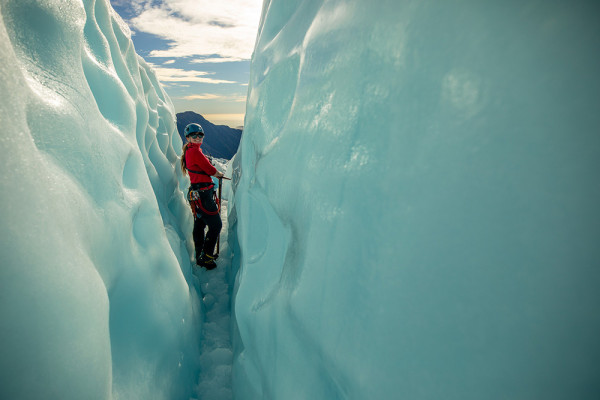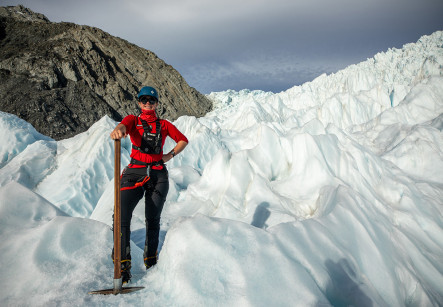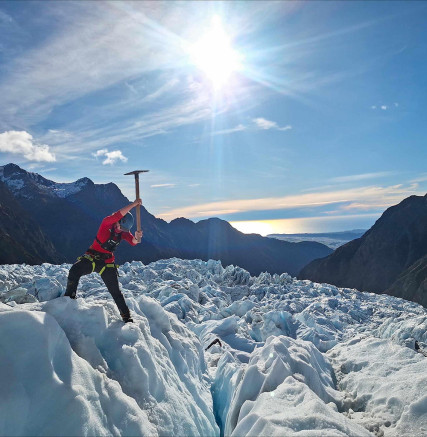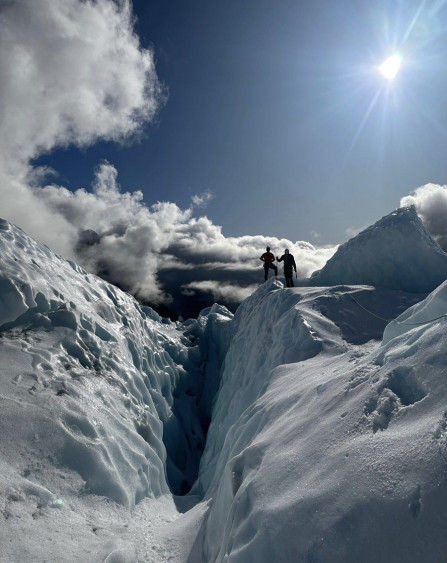Leading the way: A new generation of Glacier Guides
Aug 4, 2025


Maya Mahuika walking through a crevasse on the glacier.
In the heart of Te Tai Poutini, where the rainforest meets the ice, Franz Josef Glacier Guides has begun a new era of storytelling. For decades visitors have come to marvel at Kā Roimata o Hine Hukatere, the glacier known in English as Franz Josef. Now, under the guidance of young Kāi Tahu leaders like Maya Mahuika, the glacier is not just a natural wonder – it’s a living narrative.
Nā NIKKI-LEIGH CONDON.
MAYA, A GUIDE WITH DEEP ROOTS IN THE REGION, IS AMONG THOSE leading this cultural renaissance. She shares the Māori legend of Hine Hukatere, the adventurous woman whose tears of grief for her lost lover, Wawe, were frozen by the gods to form the glacier. This tale, passed down through generations, adds a profound layer of meaning to the icy landscape.
“When I tell the story of Hine Hukatere to our visitors, I see something shift in them,” Maya says. “Suddenly it’s not just about the ice or the view – it’s about connection. They start to understand why this place matters to us.” Maya and her team are formally trained in tikaka and delivering
cultural narratives, and their development is overseen by seasoned Hollyford Valley guide, Kahurangi Mahuika.
“Leadership has been really committed to growing cultural capability within the business,” says Kahu. “We have the people in the right positions at the top filtering down our tikanga and practices, so when people like me are training at ground level we can meet in the middle.”
This alignment between leadership and frontline staff has enabled a cohesive cultural framework to take root. Business manager Janelle Shaw says this commitment is at the heart of what makes Franz Josef Glacier Guides unique.


“It was important to me because, as a business, we have been entrusted with the responsibility of sharing the stories and tikanga of Ngāi Tahu,” she says. “We need to honour that by doing it in the most genuine and authentic way possible. It is also an opportunity to contribute to the wider understanding of te ao Māori, helping to build and strengthen that knowledge not just for our manuhiri, but for our kaimahi and future generations to come.”
The team’s cultural capability training involves more than just learning the stories of the land – it includes time on marae, lessons in tikaka, and kōrero with takata whenua. Their wānaka-based approach means the work is grounded in tikaka and mātauraka Māori.
For many guides it’s not just professional development; it’s personal reclamation. Outside of being kaitiaki of Kāi Tahu stories, the role as a guide is an extremely physical one. The glacier moves on average one metre a day, meaning the pathways guides must take are ever-changing.
“We have to cut and re-cut the steps and pathways every day,” Maya says. “No two days are the same. We’re always on the lookout for natural formations like ice caves that are forming regularly and are amazing to take our visitors through.”
And having responsibility for up to 30 people at a time in such a vast and hazardous landscape has its challenges. “We have to have eyes in the back of our heads and take every step with caution. There’s adrenaline, sure, but there’s also a huge sense of responsibility.”
Although Franz Josef Glacier Guides is a relatively recent acquisition for Ngāi Tahu Tourism (purchased in 2014), there is a longstanding history of brave Kāi Tahu whānau guiding visitors through the icy landscape.
The first recorded Kāi Tahu-guided tourism on the glacier dates back to the early 1900s, when local Māori began taking settlers and explorers across the glacier in exchange for supplies or koha.
These early guides used their intimate knowledge of the land to navigate treacherous routes long before crampons and modern ice axes were common.
This unique ownership and whakapapa connection shapes every aspect of how the business operates, Janelle says. “It gives us an authentic ability to share cultural narratives with manuhiri. These values guide everything we do, and they bring a real depth to our experiences
that sets us apart.”
Franz Josef Glacier Guides hosts more than 15,000 visitors a year, many drawn not only to the beauty of the ice but to a chance to engage with the tour’s cultural dimension.
“Manuhiri often connect deeply with the stories of the region and the people, and it helps them understand why we, as individuals and as an organisation, care so deeply for this place,” Janelle says.
The opportunity to guide on the ice not only continues the long tradition of Kāi Tahu guides on the glacier but is an employment opportunity for local Kāti Māhaki to remain employed and
live in their rohe.
“At one time there were hundreds of our people living in the wider South Westland area; now it is fewer than 50,” Kahu says. “Meaningful employment opportunities like this are so important to enable our people to remain here and continue their role as kaitiaki and ahi kā over
our takiwā.”
Embedding tikaka and cultural narrative into the day-to-day experience has also had a profound impact internally, Janelle says.
“It has been a really positive journey. For many kaimahi, it’s created a stronger connection not just to this region, but to Aotearoa as a whole. It’s given them a deeper sense of place and purpose, and that flows through to the experience they provide for our manuhiri.”
Climate change has brought further complexities. The glacier has retreated more than 1.5 kilometres in recent decades, and its retreat has shifted access routes, sometimes requiring helicopters just to reach the ice. But rather than dampen interest, these changes have brought
urgency to the work.
“People want to see it before it disappears,” Maya says. “But more than that, they want to understand what it means – why we care so much, why these places are sacred, and that’s our job. We help them see through our eyes.”
This approach blends the physical challenge of glacier guiding with cultural depth, offering visitors an experience that resonates beyond the ice.
“This isn’t just tourism,” says Kahu. “It’s a cultural transmission. It’s intergenerational knowledge being shared in one of the most awe-inspiring classrooms on Earth.”
The vision going forward is clear: to ensure Franz Josef Glacier Guides becomes a model for indigenous-led tourism worldwide; one where the landscape is not just a backdrop, but a central character in a story that began long before the first visitor arrived – and will continue long after they leave.
“As a young Ngāi Tahu woman, this work is about reclaiming space,”
Maya says. “It’s about showing our tamariki that their stories matter, that
their whenua is powerful, and that they belong here. Always.”